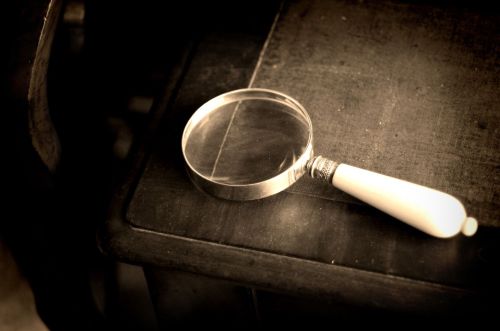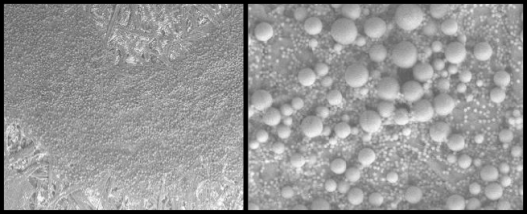“You know my methods, Watson.”
“Yes I know. It’s NANOPARTICLES.”
If Sherlock Holmes was a nanomaterial scientist, his partner might have replied as above. Yes, nanoparticles are a big deal in forensic science. If you have ever watched the TV series Crime Scene Investigation, you know that science can help us to catch criminals. As it turns out, one particular area of science—nanotechnology—is a big player in the crime solving game.

Nanotechnology can help identify fingerprints, sources of ink, and even residue from gunshots. To show us this, I’m introducing a fictional character named Dr. Nanock Holmes, who is an expert at using non-fictional nano-forensics to reveal the truth.
Upon invitation from detectives, Dr. Nanock Holmes arrived at a grisly scene on a second-floor apartment in the center of Nanoville. A single man was deceased on the floor. The man had a gun in his right hand, with his finger on the trigger. A sad farewell letter was sitting on a desk nearby, with a pen resting on top of it. All initial evidence pointed to a suicide. However, Dr. Nanock Holmes was not convinced. He retrieved the farewell letter, the pen and the deceased man’s long-sleeved shirt and headed back to his lab.
The first thing Dr. Holmes checks for are fingerprints on the letter. As a solid way to identify suspects, fingerprint analysis has been one of the most common and important techniques to solve crimes. When your finger touches anything, the raised grooves on your fingers leave traces of your sweat secreted from your eccrine glands. Traditional fingerprint analysis uses fine powders and a brush to reveal fingerprints on glasses and other flat materials. However, developing fingerprints on porous materials, like paper, is particularly difficult. Fortunately, Dr. Nanock Holmes knew that an Israeli research group had published a way to use nanoparticles to do just this. Applying this procedure, Holmes applied gold nanoparticles to the paper. Those nanoparticles were specially coated to stick to paper but not fingerprint residue. However, the fingerprint is still invisible at this point. In order to make the fingerprint visible, Holmes next applied a “developer solution” containing silver (similar to how photographs can be developed). The silver was deposited only on the non-fingerprint region of the paper, where the gold nanoparticles had become attached. This resulted in an “inverse fingerprint.”

So what did Dr. Holmes find? Well, a fingerprint was revealed—but it didn’t belong to the poor dead man. Looks like things are getting interesting. What else can Holmes, the nanomaterial scientist do?
The answer is ink analysis. Currently, the most common types of ink that contain nano-sized particles are gel inks and ink jet inks. There are two main ways to analyze ink. Besides a composition analysis to know what kinds of chemicals exist in the ink, scientists can also look at the morphology, which means the shape and size of nanoparticles in ink. Scanning electron microscopy (SEM) can help us to image the nanoparticles. This is a technique we use very often in our labs at the Center for Sustainable Nanotechnology. Below are two SEM images of a gel ink at 100X magnification (left) and at 1000X magnification (right).

After getting the analytical profile of the ink, the profile will be compared with those of a standard reference collection. When the composition of the ink sample and the size and shape of the nanoparticles inside it match those of the known reference collection, one can infer who the manufacturer of the ink is, where it is sold, when the ink first became commercially available, and in what pens the ink is used.
Interesting! Now Dr. Holmes has finished the morphology analysis of the ink on the letter and the gel ink from the pen which was found uncapped on the farewell letter on the desk. It sure seems like that pen was the one used to write the will. Bang! Nanoparticles tell the truth. Holmes’ analysis revealed that these two inks are definitely from two different manufacturers, indicating that the farewell letter was not written using the pen on the desk. What do you think? It sure seems like someone forged the farewell letter with a different pen.
Think that the work for the nanomaterial scientist is done? Nope!
Don’t forget we have another piece of evidence—the long-sleeve shirt. Gun-shot residue analysis is always a critical step in forensic investigations involving shooting. Upon firing a gun, both burned and unburned powder form a cloud that may cause a roughly circular pattern around the bullet hole upon contact. The gun-shot residue commonly spreads up to 36 inches away from the bullet hole, and this gun-shot residue contains nanoparticles! By looking at the shape, size and element composition of nanoparticles in gun-shot residue, one can determine from what distance the gun was shot and also what kind of gun was used.
Had it been suicide, scientist should have also found nanoparticles on the sleeves of the dead man. Guess what? Dr. Holmes doesn’t find anything. There are nearly identical nanoparticles on the gun and around the wound, but none on the man’s sleeves. That means the dead man could not have been the one who fired the gun. It is likely that someone else shot him and then put the gun in his hand, making it seem like a suicide.
Now we see: everything Dr. Nanock Holmes has done to reveal the truth made use of nanoparticles. In the analysis of fingerprints, inks, gun-shot residues, and much more (like explosives residues), nanoparticles are helping us reveal what conventional investigation methods cannot. Maybe one day, more and more people like Dr. Nanock Holmes will be around us, and they would say in confidence: “Hey, you know my methods, so don’t you dare to commit a crime—‘cause nanoparticles will tell us the truth!”
References and Further Reading:
New Nanotech Fingerprint Analysis Promises to Uncover New Clues in Cold Cases
Inverse Fingerprints on Paper Visualized with Nanotechnology
Processes to Develop latent Prints on Porous surfaces
New Method Developed to Capture Fingerprints On Difficult Surfaces
Method and system for characterizing nanoparticles in a gun-shot residue
Nano-Forensics—Nanoparticles in Gun-Shot-Residue (subscription required)
Optics and Photonics for Counterterrorism and Crime Fighting (subscription required)
Forensic Fingerprint Enhancement using Bioadhesive Chitosan and Gold Nanoparticles (subscription required)
